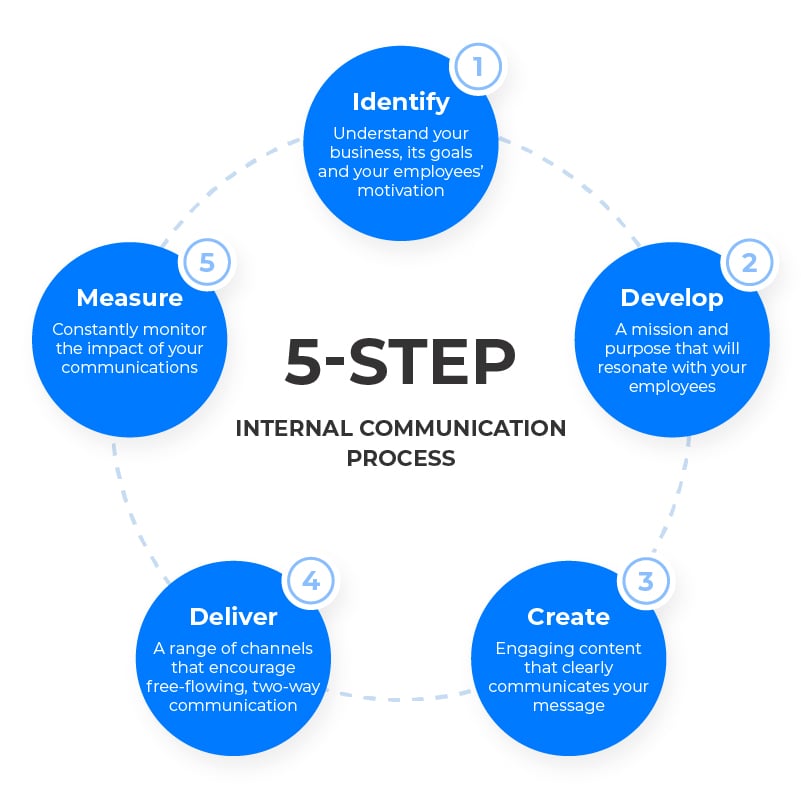Is it time to take a fresh look at your internal communications? The fact is, many businesses believe they have their strategy all sewn up, while behind the scenes their employees are less than happy.
Recent research from Evergreen suggests that employees spend up to two hours a day worrying and gossiping. Think about it; this is 25% of their working week. Especially in times of trouble and uncertainty, workers are more likely than ever to feel anxious about their role and position. A Metlife poll suggests 33% of workers are worried their pay will be cut; 30% are worried about getting laid off and 30% are worried their hours will be cut. This is a lot of time spent worrying, and therefore a lot of time spent being unproductive and ultimately unprofitable.
However, once you create an organisation with connected and informed employees, productivity improves up to 25%. Instead of spending hours agonising over working conditions, employees feel confident and relaxed enough to focus on the job in hand, and actually go over and above their remits in order to work towards a common goal.
And how do you achieve this desirable situation? With a strong, defined internal communication strategy in place. In this blog, we take an in-depth dive into the five easy-to-implement steps of the internal communication process. Put these in place and you’ll be on the right path to improve internal communication in your organisation and be on the fast track to success.

Step 1: Identify
Understand your business, its goals and your employees’ motivation
At the core of every strategy is the implicit understanding of your business and what it’s trying to achieve. You need to take a careful look at the following:
- The current situation of your business
- The overall goals of the organisation
- The goals of your internal communication
- Your audience and what motivates them
This is crucial when it comes to laying down a strategy. One of the key internal communication best practices is to ensure you are working with the full spread of information laid out in front of you. Guesswork and approximation are not an option when it comes to setting out your internal communications plan.
There is no one-size-fits-all solution to internal communications. Every business will have a different focus, a singular set of challenges and its own unique profile of employees. For example, an organisation trying to navigate a takeover will have a very different set of requirements than one that is trying to launch off the ground for the first time. Equally, a company focusing on profit margins will take a different approach to one that is trying to steer a course through a crisis situation. Communication in a crisis requires a completely different methodology. Your strategy needs to pinpoint the particular needs and issues of your company, at this particular point in time, and address them individually.
It’s important to think of internal communication as marketing to your internal audiences. Just like external marketing, it is best done with a finely targeted purpose in mind, and it is only truly successful when tailored specifically to a distinct target audience. Companies often try to achieve communicating with employees with broad brush strokes, but what is actually called for is a sharply-defined internal communications process.
Step 2: Develop
A mission and purpose that will resonate with your employees
What does your company actually stand for? A key employee communication process is to clarify this position and make sure that it is clearly conveyed to your employees. You need to spell out the following points:
- How and why the company operates
- What the company does for its customers
- What the company does for its employees
- What the company does for the wider community
This is an opportunity to spell out the company’s ethics and culture, as well as its profit-driven goals. While this may sound like unnecessary fluff when weighed against the bottom line of annual turnover, it is a vital internal communication definition that should not be overlooked.
A Gallup report revealed that a compelling sense of purpose will drive organisations towards positive business outcomes. In fact, they benefit from 5%-15% higher profitability as a result.
Equally, a lack of purpose will have a negative effect. Currently, only four in 10 employees strongly agree that their company mission makes them feel their job is important.
When a company’s purpose makes employees feel they have a personal role in its success, they are more likely to be engaged and highly productive. They are also more likely to stay in their roles. When employees strongly agree that they know what their company stands for, nearly eight in 10 strongly agree that they plan to remain with the organisation for at least one year. The benefits of good internal communication in the delivery of the company mission statement are numerous.
Step 3: Create
Engaging content that clearly communicates your message
Your employees are busy and distracted. If you want them to pay attention to the messages you’re firing out, you need to put some real effort into them. That’s why this step of the internal communication process flow chart is so important.
- Create dynamic content that jumps out from their inbox
- Tell the company story in a variety of ways
- Publicly recognise achievements and successes
- Promote knowledge as well as news
- Include light-hearted elements as well as serious reports
With employees pulled in so many different directions throughout the day, you have to somehow filter through the noise and ensure your messages are actually noticed. The answer? Your internal communications have to be interesting. Effective internal communication means taking the time to connect and resonate with your audience.
Fortunately, you are on to a winning ticket. A Gallup report revealed that 80% of employees do actually want to receive company news and updates: 77% said it would help them at their job and 66% said it helps them build better relationships with their colleagues. So, if you’re aiming to improve internal communication, your mission is to find a way to get your messages heard.
Something as simple as acknowledging achievement can have a dramatic impact on engagement levels. According to TinyPulse, when asked what leaders could do more of to improve engagement, 58% of respondents replied “give recognition”.
Step 4: Deliver
A range of channels that encourage free-flowing, two-way communication
Quite simply, you need to put the right internal communication channels in place. How effectively a message is delivered is just as important as the content of the message. With both the internal and external business communication process, you need to implement the following elements:
- Channels that fit your objectives
- Channels that connect with your target audience
- Channels that reach everyone, even the hard-to-reach
- Channels that encourage a two-way stream of communication
We are no longer limited to emails and newsletters. Now we have a huge range of communication channels to choose from, including intranets, videos, conferencing tools, social media and internal communication apps. With so many options at your disposal, it can be a confusing dilemma.
For example, if you decide to set up a new employee intranet in order to pump out your messages, this will only be successful if every single employee has the access required to access the intranet. If you have remote workers or technology-shy employees who are left out the loop, your strategy will have failed before it’s even left the drawing board. An internal communication platform is the better option in this scenario, as it removes such barriers, by allowing employees to use their favourite means of communication, whichever hardware or software platform they prefer.
A key role of internal communication is to encourage feedback and participation. This is where the importance of a two-way channel really comes to the fore. Your aim is to encourage staff to get involved and take action. Make sure you implement feedback channels by inviting responses and opening up new opportunities to interact. One of the common internal communication mistakes is to fail to instigate this essential two-way flow of information. If you don’t know what your employees are thinking, how can you act appropriately?
Step 5: Measure
Constantly monitor the impact of your communications
This is the final step of the internal communication process, and the most crucial one. Unless you continually evaluate engagement levels and adjust your plans accordingly, you will find your strategy quickly fails to deliver.
- Understand your audience by comparing teams and divisions
- Measure employee performance and uptake
- Monitor your eNPS to keep track of loyalty levels
- Schedule regular pulse reports and check-ups
Measuring internal communications will often make the difference between success and failure. With an internal communications app, you will find it is simple to conduct in-depth analysis of engagement levels with regular and scheduled check-ups.
If you have recently launched the app, you can easily monitor the success of your roll-out by keeping a close eye on onboarding rates as the app launches across the company. Once established, in-built reporting will keep track of engagement levels effortlessly, while real-time dashboards deliver an instant view whenever required.
This in-depth level of analysis simply isn’t accessible with more traditional internal communication channels. It is impossible to tell if emails have been read and acted upon. Newsletters can sit on desks, ignored and unopened. Even with a conference call, it is difficult to determine whether a message has been understood correctly.
Measuring impact is key element of the internal communication process. By assigning regular reports and feedback to help you refine your strategy, you’ll find your business performance hits new heights of success. In other words, it’s the key to running a profitable business.
Topics:
Internal Communications






.jpg)
.jpg)